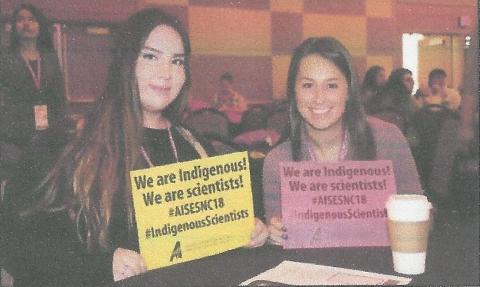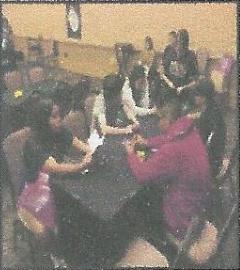 |
Canku Ota
|
 |
|
(Many Paths)
|
||
|
An Online Newsletter
Celebrating Native America
|
||
|
November 2018 - Volume
16 Number 11
|
||
|
|
||
|
No Dream Is Too Big:
Annual AISES National Conference Returns To Oklahoma
|
||
|
by Latoya Lonelodge
- Staff Reporter, Cheyenne & Arapaho Tribal Tribune
|
||
Students, professionals and educators alike, are pursuing interest in the world of Science, Technology, Engineering and Math (STEM) as various tribal attendees across the nation came together to take part in a one-of-a-kind event. Oct. 4-6 the annual American Indian Science and Engineering Society (AISES) National Conference was held at the Cox Convention Center in Oklahoma City. With the convention attracting over 2,000 American Indian STEM students, educators and professionals, AISES focused on inspiration, networking and creating an interactive atmosphere for students to engage. Groups of students and attendees made it a priority to support and embrace the fun and energetic environment of AISES, specifically held for students to engage in educational, professional and workforce development. “AISES is a phenomenal organization, we started some 41 years ago right here in Oklahoma. Our founding fathers really focused on how do we help the transition for those living on reservations to get an education in STEM so they’re able to go back home or go be successful in whatever they want to do with a great educational background. Native American students really struggle sometimes because family is such an important part of who we are, in fact the elders play an important role here, it’s one of the only organizations where elders play such an important part because it’s all about relationships, our engagement, we learn from those who walk before us so with that as a foundation we have a great program for our youngsters to be engaged from pre college, college and professionals,” Rick Stephens, AISES vicechair said. When AISES first began in 1978, the organization had a hard time creating awareness due to the idea of Indian scientists and engineers being an actual profession among Native Americans. “Being an Indian scientist engineer is the most natural thing for our people because that’s something who we’ve been for thousand of years, we shouldn’t be looked at as some kind of academic person but rather a natural person who has natural ways with the mother earth and awareness. I’m a physicist but that enabled me to study the earth and all the lessons here in a different way than other people because of my attachment to the earth and her ways. So we, for thousands of years in this country, have been scientists and engineers we just never went to school for it but many of our people, through medicines, through healing and all kinds of things, we contributed a lot to this society even the teepee’s an amazing engineering design, it’s the geometrical shape that the wind can’t topple over, it’s particle and keeps our people warm and safe. The arrow is truly aerodynamics,” J.C. Elliott High Eagle, AISES founder said. High Eagle said native people have a place in society and in the world. “I want the world to know more about our people, more than just a Hollywood image that we’ve been portrayed for so many years,” High Eagle said. With particular challenges in the field of STEM, High Eagle said he’d like to see more American Indians, especially women, involved in technical careers. “For a long time there’s been a connotation that if you’re a woman then you shouldn’t be in these kind of professions and I’d like to see that grow for the benefit and participation of women. Science and engineering don’t care if you’re a man or woman, it cares about your mind, how your mind thinks so there’s lots of opportunities for women in the future and I’d like to see more involved in technical careers and in management, get involved and it’s not a competitive thing, it’s just allowing more diversity and thought in what we do and women have also a way of thinking that men don’t have sometimes so it’s good to include that,” High Eagle said. In expanding AISES over
time, the conference looks to grow in educational opportunities
and provide those opportunities to its “I’d like to see more AISES members, I’d like to see more companies getting involved with AISES and supporting us and most importantly making scholarship opportunities available, education opportunities available for our people because some of our people come from very traditional families and very low income and sometimes it’s difficult for people who want to advance in science and engineering to do so because of the cause so that’s another major accomplishment of AISES they’ve been able to get scholarships but I’d like to see that continue and grow in the future,” High Eagle said. The AISES conference holds true to its board members and employees who stand behind the conference’s goals. John Herrington, retired naval aviator, test pilot and astronaut, is on the board of directors and was a keynote speaker for AISES. “The idea is to
try to increase the number of representation of Native Americans
in science and engineering communities because we’re the least
represented minority and it’s not because we’re incapable,
it’s because you got to find things people are passionate about
and get them motivated to want to learn and once you find that trigger,
there are people that can help you, that’s what AISES is, a
place for mentors and professionals to work with students and say
‘hey this is what you can do, this is what I did, you can do
the same,’ and hopefully they’ll follow in that same path
and lead a successful career in communities and
While AISES aims to increase its participation and interest for STEM, AISES Director of Marketing and Communications, Montoya Whiteman said it’s important to reach younger audiences in the K-12 grades, and even before then. “It’s to plant that seed of curiosity and discovery and link it to our Indigenous heritage because we are Indigenous scientists, our ancestors are Indigenous scientists, we were the first geologists, we were the first environmentalists, we were the first earth sciences and so we have that expertise and its genetic, it’s in our genes and it’s in our spirit, it makes up who we are. It’s our genetic makeup and so that’s what gets me passionate about working with AISES is that I’m able to return to my own communities and to Native students and those are going to be the scientists of tomorrow, we could have the second Native American astronaut in this room, that’s a really tough and high dream but that doesn’t mean that it’s impossible,” Whiteman said. And Whiteman believes through AISES, no dream is too big and the opportunities in the field of STEM are endless for native youth. “STEM jobs are the highest paid, they’re the highest sought after and so we want to get in on that, those are the jobs of the future and so what’s important for us and the challenge is that we want to be able to get students into that work force, get them in that pipeline and to be interested in science, work on their grades, have good grades, really have the chance to dream big and strategize and have a plan as they’re going through that pipeline and be able to achieve what they want to and it all really comes down to exposure … That’s what we’re trying to do is we’re trying to increase that exposure to STEM and what STEM can offer an individual and their families and part of that is there’s good paying jobs out there for STEM,” Whiteman said. As the conference overflowed with enthusiasm for growth in academics, the challenges most often associated with pursuing a STEM curriculum seemed to diminish as attendees applauded one another in each individual’s success. “A word to the Indian students is never give up, it’s always been my motto no matter how difficult these things are, never give up because we can and we always have, that’s why we’re still here, we never gave up. We’re still a people that accepts challenges and today we’re accepting an academic challenge, for the past we had our challenges to survive with our people being here so our priorities have switched now to different challenges and I always say you can do it, you can make it happen,” High Eagle said |
||||
|
|
|
|
||
|
|
||
| Canku Ota is a free Newsletter celebrating Native America, its traditions and accomplishments . We do not provide subscriber or visitor names to anyone. Some articles presented in Canku Ota may contain copyright material. We have received appropriate permissions for republishing any articles. Material appearing here is distributed without profit or monetary gain to those who have expressed an interest. This is in accordance with Title 17 U.S.C. Section 107. | ||
|
Canku Ota is a copyright ©
2000 - 2018 of Vicki Williams Barry and Paul Barry.
|
||
 |
 |
|
|
The "Canku
Ota - A Newsletter Celebrating Native America" web site and
its design is the
|
||
|
Copyright ©
1999 - 2018 of Paul C. Barry.
|
||
|
All Rights Reserved.
|
||

